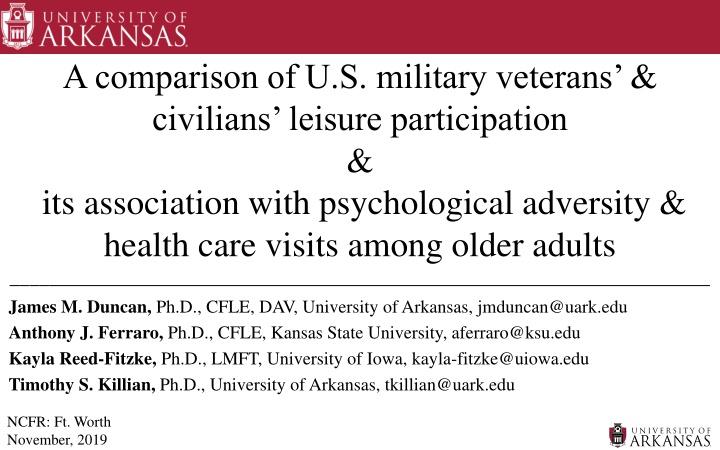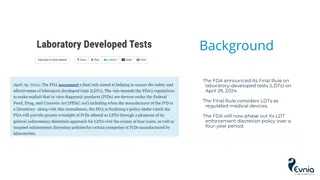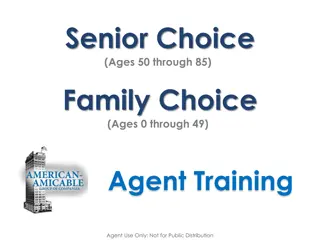
Comparison of U.S. Military Veterans & Civilians Leisure Participation
Explore the association between leisure participation, psychological adversity, and health care visits among older U.S. military veterans and civilians. Discover how social leisure can impact optimal functioning and well-being in aging populations.
Download Presentation

Please find below an Image/Link to download the presentation.
The content on the website is provided AS IS for your information and personal use only. It may not be sold, licensed, or shared on other websites without obtaining consent from the author. If you encounter any issues during the download, it is possible that the publisher has removed the file from their server.
You are allowed to download the files provided on this website for personal or commercial use, subject to the condition that they are used lawfully. All files are the property of their respective owners.
The content on the website is provided AS IS for your information and personal use only. It may not be sold, licensed, or shared on other websites without obtaining consent from the author.
E N D
Presentation Transcript
A comparison of U.S. military veterans & civilians leisure participation & its association with psychological adversity & health care visits among older adults ______________________________________________________________________ James M. Duncan, Ph.D., CFLE, DAV, University of Arkansas, jmduncan@uark.edu Anthony J. Ferraro, Ph.D., CFLE, Kansas State University, aferraro@ksu.edu Kayla Reed-Fitzke, Ph.D., LMFT, University of Iowa, kayla-fitzke@uiowa.edu Timothy S. Killian, Ph.D., University of Arkansas, tkillian@uark.edu NCFR: Ft. Worth November, 2019
The Aging Population As of 2015 it was estimated that there were nearly 47.8 million individuals age 65 & older in the U.S. projections suggest numbers will double over the next four decades Some older adults experience declines in cognitive function Other older adults experience declines in physical functioning Still some experience declines in both physical & cognitive functioning When examining health outcomes & the impact of aging, an important population to consider are U.S. military veterans Military populations generally have poorer mental health than civilians Military populations generally have poorer physical health than civilians Military populations tend to have poorer health behaviors than civilians Alexandre et al. 2014; U.S. Census Bureau, 2017; Kessler et al., 2014 Hoerster et al. 2012, McKhann et al., 2011
Current Study Considering the growing military population, as evidenced by recruitment statistics, the subpopulation of aging veterans with a higher propensity for adverse health outcomes will continue to grow The current study sought to investigate if and how social leisure is associated with psychological adversity & health care visits among older adults in an effort identify mechanisms that can promote optimal functioning through the aging process U.S. DoD 2014 & 2015
Why Social Leisure? When considering the concept of social integration leisure makes sense as a potential mechanism that can promote optimal human functioning Specifically, social leisure helps to integrate individuals with meaningful others through participation in shared social activities where acts of social support & social influence can be expressed This is particularly salient for older adults & older adult veterans, as lack of social integration has been linked to low levels of social support & higher psychological adversity Additionally, research has shown high levels of social integration to be associated with positive perceptions of social influence to seek out & utilize health care Thoits, 2011; Coyle & Dugan, 2012; Hatch et al., 2013; Spoont et al., 2014
Hypotheses H1: (social leisure as a predictor): It was expected that higher social leisure participation, would be associated with lower psychological adversity &, in turn, those with high psychological adversity would report higher health care visits H2: (veteran status as a moderator): It was expected that there would be significant differences on all study variables, social leisure as well as psychological adversity and health care visits, between individuals who identified as having veteran status versus those identified as civilians
Measures Social Leisure Participation Predictor measured with three items, how often did you Volunteer work for religious, charitable, political health-related, or other organizations? Attend meetings of any organized group Get together socially with friends or relatives Time 1: =.64; Time 2: =.69 Psychological Adversity Latent variable measured by anxiety, depression, & stress 7-item reduced version of the Hospital Anxiety & Depression Scale 4-item reduced version of the Perceived Stress Scale Time 1: =.70; Time 2: =.71 Health Care Visits Outcome variable measured by a single item Measured by asking over a 12-month period How many times have you seen a doctor or other health care professional about your health at a doctor s office, a clinic, hospital emergency room, at home or some other place Veteran Status A single item was used to assess moderation Have you ever served in the active military of the United States? Zigmond & Snaith, 1983; Cohen et al., 1994
Analytic Sample The data used for this study originated from waves one & two of the National Social Life, Health, & Aging Project Nationally representative longitudinal study of individuals over the age of 57 Original data collection occurred in a face-to-face format by researchers from the University of Chicago, who asked questions exploring social relationships, physical health, cognitive health, & health behaviors of older adults Participants among the analytic sample Time 1=1,194 & Time 2=809 35.1% identified as having prior military service 56% of the sample was male Majority identified as White (78.7%) 59.6% were between the ages of 65-74 40.4% were between the ages 75-85 60.2% married 82.0% had a High School Diploma or higher education Waite et al., 2010-2011; Waite, Laumann, Levinson, Lindau, and O Muircheartaigh, 2005-2006
Analysis A series of path models were fitted in AMOS 26 using full information maximum likelihood Control variables included: age, gender, education level, physical functioning level, relationship status, ethnicity Several fit indices were used: Normed Fit Index (NFI) Comparative Fit Index (CFI) Tucker-Lewis index (TLI) root mean error approximation (RMSEA) In general, NFI, CFI, and TLI between .90 & .95 indicate adequate fit & above .95 indicate good fit, & rmsea values below .05 indicate good fit, with values between .05 to .08 indicating adequate fit Following examination of model fit the Sobel test was used to examine indirect effects This test can be used to examine the significance of mediation among normally distributed samples with normality being examined with skew & kurtosis values (which were deemed to be in an acceptable range for this study) Browne & Cudeck, 1993; Sobel, 1982; Curran et al., 1996
Results H1: results indicated good fit & after accounting for time 1 reports of study variables, social leisure participation was significantly related to decreased psychological adversity, &, in turn psychological adversity was significantly related to health care visits H2: constrained & unconstrained path models were examined with an AMOS plugin using chi-square results to determine measurement invariance & results indicated there was no group moderation based on veteran status (NFI=.94, CFI=.96, TLI=.94, rmsea=.03) (Sobel test: z=-2.08, p<.05) ( 2=186.36, df=96, critical 2 p=1.00) Gaskin & Lim, 2018
Discussion The purpose of this study was to investigate the role of social leisure participation in its association with psychological adversity & health care visits among older adults, with a specific interest in examining if differences between veterans & civilians existed Higher levels of social leisure = lower psychological adversity Higher psychological adversity = higher health care visits Veteran status moderator between study variables Suppositions from the findings are that social leisure participation facilitates social relationships This provides opportunity for individuals to receive social support to dissuade potential psychological adversity It also provides opportunity for social influence, by helping others identity mental health illnesses as they occur & encouraging health care visits Among this sample, findings are relevant to older adults both veteran & civilian alike
Limitations Veteran status only asked if a person had prior military history Future research could consider looking beyond military service & explore other military contexts (number of past deployments, traumatic experiences including combat exposure, military branch affiliation, etc.) Leisure scale not an established measure Continued validation is needed Outcome variable chosen based on the extent of the frequency an individual reported seeking out health care services Future research may consider using scales that investigate specific types of health care services as to better understand what types of services are used (e.g., walk-in clinics, emergency rooms, etc.)
Headline News Socially supportive leisure environments are key to successful individual functioning for older adults Volunteering Participating in community organizations Interacting with friends & family So how do we help? Promote social leisure as a mechanism that can be used in conjunction with formal support systems Disseminate findings to community practitioners Area Agency on Aging & Veteran Affairs Promote open communication about mental health Informal networks can encourage health care visits family, friends, church groups, sports leagues, etc.
References Alexandre, T. D. S., Corona, L. P., Nunes, D. P., Santos, J. L. F., Duarte, Y. A. D. O., & Lebr o, M. L. (2014). Disability in instrumental activities of daily living among older adults: gender differences. Revista De Saude Publica, 48, 379-389. doi: 10.1590/S0034-8910.2014048004754 Barrett, P. (2007). Structural equation modeling: Adjudging model fit. Personality and Individual Differences, 42(5), 815 824. doi: 10.1016/j.paid.2006.09.018 Browne, M. W., & Cudeck, R. (1993). Alternative ways of assessing model fit. In K. A. Bollen, & J. S. Long (Eds.), Testing structural equation models (pp. 136 162). Newbury Park, CA: Sage. Cohen, S., Kamarck, T., & Mermelstein, R. (1994). Perceived stress scale. Measuring stress: A guide for health and social scientists, 1, 235-283. Coyle, C. E., & Dugan, E. (2012). Social isolation, loneliness and health among older adults. Journal of Aging and Health, 24(8), 1346-1363. doi: 10.1177/0898264312460275 Curran, P. J., West, S. G., & Finch, J. F. (1996). The robustness of test statistics to nonnormality and specification error in confirmatory factor analysis. Psychological Methods, 1(1), 16- 29. doi: 10.1037/1082- 989X.1.1.16 Gaskin, J. & Lim, J. (2018), "Multigroup Analysis," AMOS Plugin. Gaskination's StatWiki. Hatch, S. L., Harvey, S. B., Dandeker, C., Burdett, H., Greenberg, N., Fear, N. T., & Wessely, S. (2013). Life in and after the Armed Forces: social networks and mental health in the UK military. Sociology of Health & Illness, 35(7), 1045-1064. doi: 10.1111/1467-9566.12022 Hoerster, K. D., Lehavot, K., Simpson, T., McFall, M., Reiber, G., & Nelson, K. M. (2012). Health and health behavior differences: US Military, veteran, and civilian men. American Journal of Preventive Medicine, 43(5), 483-489. doi: 10.1016/j.amepre.2012.07.029 Hu, L., & Bentler, P. M. (1999). Cutoff criteria for fit indexes in covariance structure analysis: Conventional criteria versus new alternatives. Structural Equation Modeling, 6(1), 1 55. doi: 10.1080/10705519909540118 Kessler, R. C., Heeringa, S. G., Stein, M. B., Colpe, L. J., Fullerton, C. S., Hwang, I., ... & Schoenbaum, M. (2014). Thirty-day prevalence of DSM-IV mental disorders among nondeployed soldiers in the US Army: Results from the Army Study to Assess Risk and Resilience in Servicemembers (Army STARRS). JAMA psychiatry, 71(5), 504-513. doi: 10.1001/jamapsychiatry.2014.28McKhann, G. M., Knopman, D. S., Chertkow, H., Hyman, B. T., Jack, C. R., Kawas, C. H., ... & Mohs, R. C. (2011). The diagnosis of dementia due to Alzheimer s disease: Recommendations from the National Institute on Aging-Alzheimer s Association workgroups on diagnostic guidelines for Alzheimer's disease. Alzheimer's & Dementia: The Journal of The Alzheimer's Association, 7(3), 263-269. doi: 10.1016/j.jalz.2011.03.005 Sobel, M. E. (1982). Asymptotic confidence intervals for indirect effects in structural equation models. Sociological Methodology, 13(1982), 290-312. doi: 10.2307/270723 Spoont, M. R., Nelson, D. B., Murdoch, M., Rector, T., Sayer, N. A., Nugent, S., & Westermeyer, J. (2014). Impact of treatment beliefs and social network encouragement on initiation of care by VA service users with PTSD. Psychiatric Services,65(5), 654-662. doi: 10.1176/appi.ps.201200324 Thoits, P. A. (2011). Mechanisms linking social ties and support to physical and mental health. Journal of health and social behavior, 52(2), 145-161. doi: 10.1177/0022146510395592 U.S. Census Bureau, U.S. Department of Commerce, Newsroom. (2017). Facts for features: Older Americans Month: May 2017. Retrieved from: https://www.census.gov/newsroom/facts-for-features/2017/cb17- ff08.html U.S. Department of Defense, Defense Media Activity. (2014). DoD announces recruiting, retention numbers for fiscal June 2014. Retrieved from https://www.defense.gov/News/News-Releases/News-Release- View/Article/605268/dod- announces-recruiting-and-retention-numbers-for-fiscal-2014 U.S. Department of Defense, Defense Media Activity. (2015). DoD announces recruiting, retention numbers through June 2015. Retrieved from http://www.defense.gov/News/Article/Article/612742/dod- announces-recruiting- retention-numbers-through-june-2015 Zigmond, A. S., & Snaith, R. P. (1983). The hospital anxiety and depression scale. Acta Psychiatrica Scandinavica,67(6), 361-370. doi: 10.1111/j.1600-0447.1983.tb09716.x Waite, L. J., Cagney, K. A., Dale, W., Huang, E., Laumann, E. O., McClintock, M. K., Cornwell, B. (2010-2011). National Social Life, Health, and Aging Project (NSHAP): Wave 2 and Partner Data Collection, [United States], 2010-2011. Ann Arbor, MI: Inter-university Consortium for Political and Social Research [distributor], 2018-06-22. https://doi.org/10.3886/ICPSR34921.v3 Waite, L. J., Laumann, E. O., Levinson, W. S., Lindau, S. T., and O Muircheartaigh, C A. (2005-2006). National Social Life, Health, and Aging Project (NSHAP): Wave 1, [United States], July 2005-March 2006. Ann Arbor, MI: Inter-university Consortium for Political and Social Research [distributor], 2018-06-22. https://doi.org/10.3886/ICPSR20541.v8


![READ⚡[PDF]✔ Yup I'm Dead...Now What? The Deluxe Edition: A Guide to My Life Info](/thumb/20463/read-pdf-yup-i-m-dead-now-what-the-deluxe-edition-a-guide-to-my-life-info.jpg)

















